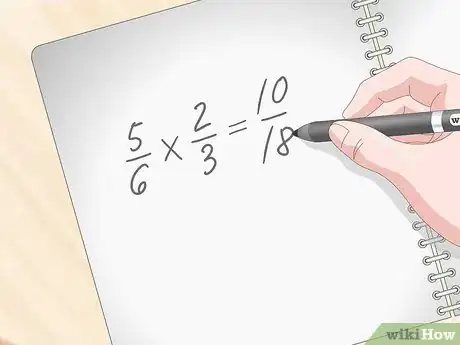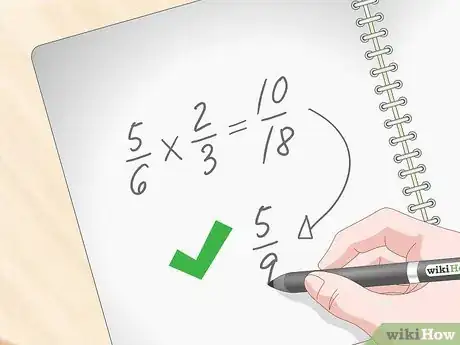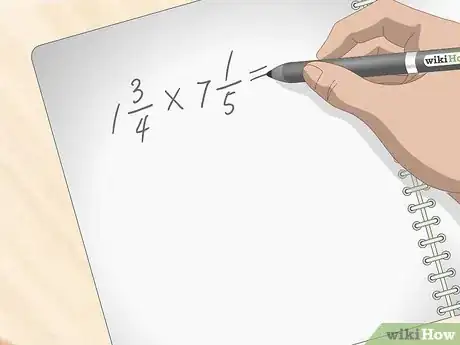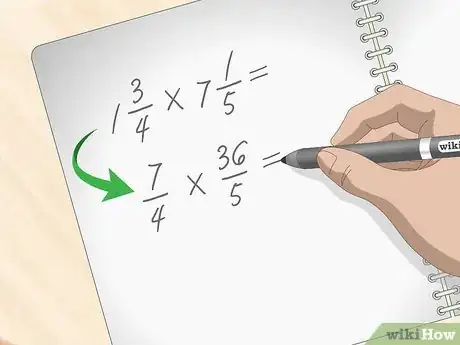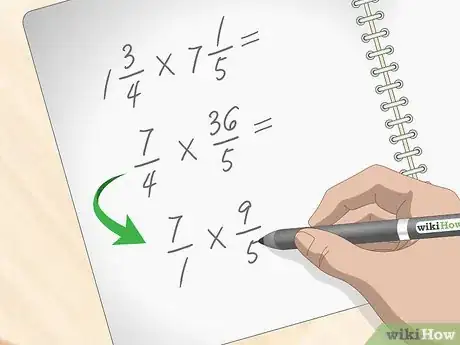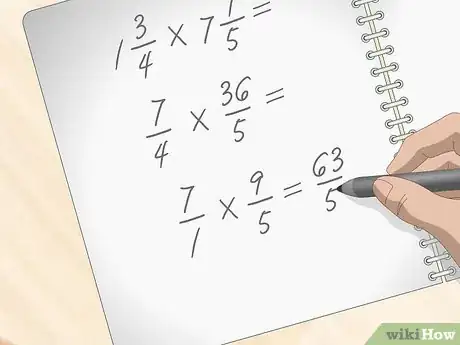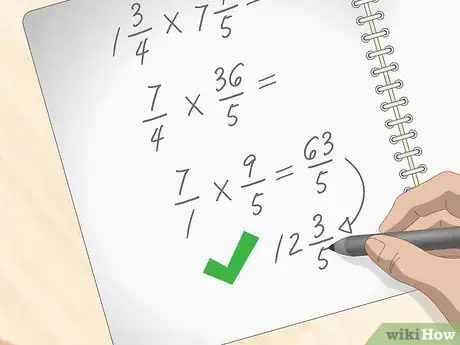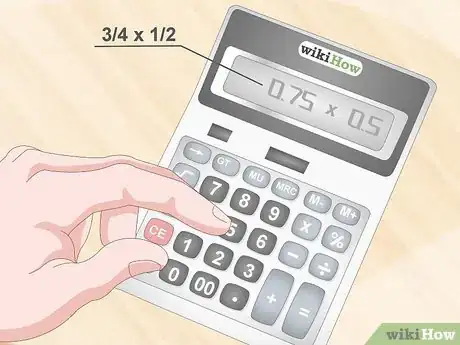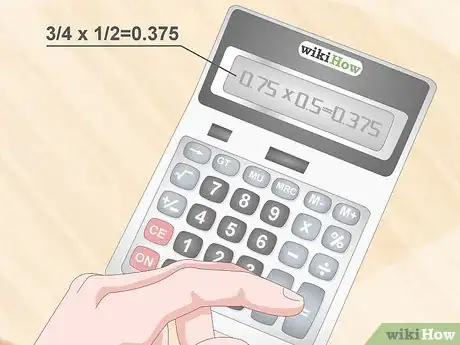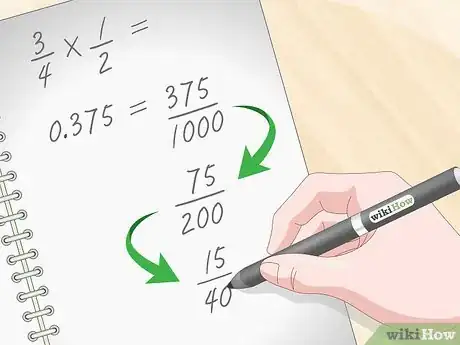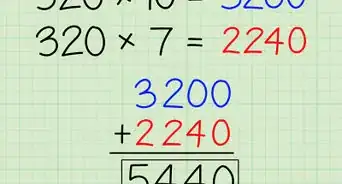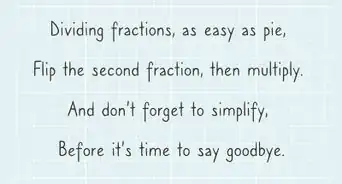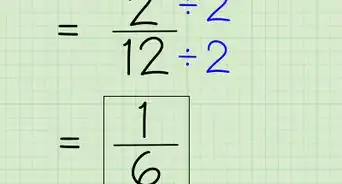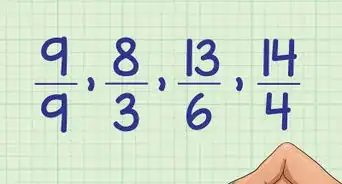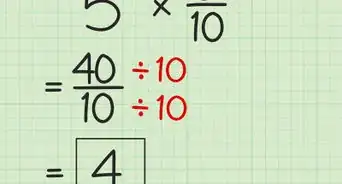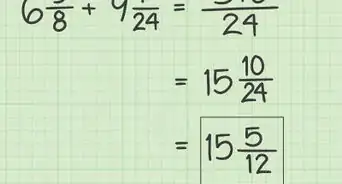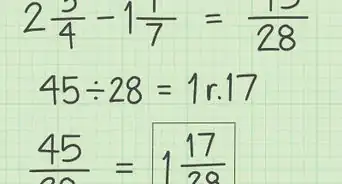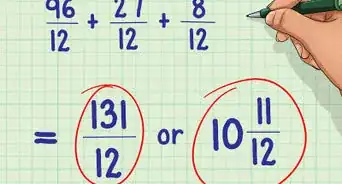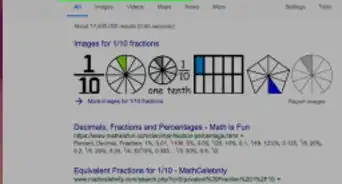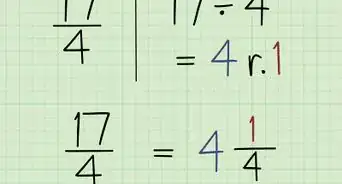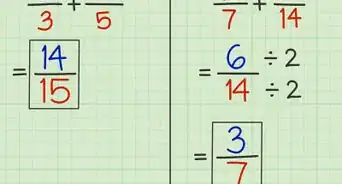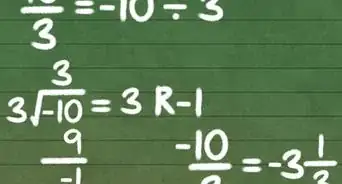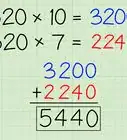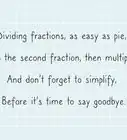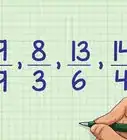This article was co-authored by Mario Banuelos, PhD. Mario Banuelos is an Assistant Professor of Mathematics at California State University, Fresno. With over eight years of teaching experience, Mario specializes in mathematical biology, optimization, statistical models for genome evolution, and data science. Mario holds a BA in Mathematics from California State University, Fresno, and a Ph.D. in Applied Mathematics from the University of California, Merced. Mario has taught at both the high school and collegiate levels.
There are 11 references cited in this article, which can be found at the bottom of the page.
This article has been viewed 512,401 times.
Multiplying fractions might seem a little daunting at first, but once you get the hang of setting up your equation, you’ll be able to get those answers in no time! Turn mixed numbers into improper fractions, multiply numerators and denominators, and simplify your fraction to get the final answer to the question. Take your time and work step by step so you can check your work as you go.
Steps
Multiplying Simple Fractions
-
1Write down the problem on a piece of paper. Being able to see your work will help you learn how to multiply fractions better. Plus, if you make a mistake, it’ll be easier to go back in your work to see the error. Each fraction has a numerator (the number on the top) and a denominator (the number on the bottom). Separate the numerator from the denominator with a straight, horizontal line.[1]
- Try your best to keep your fractions in a straight line. This will just make it easier to stay organized and work efficiently.
-
2Multiply the numerators first.[2] [3] For example, if you’re asked to solve for 5/6 * 2/3, the first thing you’ll need to do is multiply 5 * 2, which gives you 10. This will be the numerator for your answer.[4]
- In another example, solve for the numerator of 3/4 * 1/3. Any number times 1 will be itself, so your new numerator is 3.
Advertisement -
3
-
4Simplify your new fraction to get it in the lowest form possible. If the numerator and denominator share common factors (they can be divided equally by the same number), you can simply your answer. For the example of 5/6 * 2/3, the answer you got was 10/18. Both 10 and 18 are divisible by 2. Divide both numbers by 2 to get your final, simplified answer, which is 5/9.[7]
- Simply the fraction 3/12. 3 goes into both itself and 12 evenly. The simplified answer is 1/4.
Working with Mixed Numbers
-
1Write the problem down on paper so you can keep track of your work. You may be tempted to solve math problems in your head, but when you’re first starting out it’s a good idea to write everything down, step by step. This way, if you make a mistake, it’s easy to go back and see what happened so you can fix it moving forward.
- Fractions are made up of 2 parts, the numerator (the top number) and the denominator (the bottom number), and they are separated with a straight, horizontal line. To write a mixed number, put the whole number on the left-hand side of the fraction.
-
2Change the mixed number to an improper fraction. For example, let’s say the problem you’re solving for is 1 and 3/4 * 7 and 1/5. The first thing you need to do is change both of those mixed fractions into improper fractions, meaning that the numerator will be greater than the denominator. Here’s how to do this: [8]
- 1 and 3/4 = 7/4 when it’s made into an improper fraction. The denominator will always stay the same when making improper fractions. Multiply the denominator by the whole number (4 *1) and add that answer to the current numerator (3). (4*1) + 3 = 7.
- For 7 and 1/5, multiply the denominator by the whole number (5*7) and add that answer to the current numerator (1). (5*7) + 1 = 36. Put the new numerator over the original denominator for your improper fraction. 7 and 1/5 = 36/5.
-
3Simplify the improper fractions to make the numbers easier to multiply.[9] In the example given, we are left with 7/4 * 36/5. While you could just multiply the numerators and the denominators, it will be easier to do the math if you can simplify the fractions first. When simplifying, check to see if the cross numerator and denominator can be divided equally by the same number.[10] 7 and 5 cannot be, but 36 and 4 are both equally divisible by 4. To get your simplified fraction:[11]
- Divide 4 by 4 to get 1, changing the first fraction from 7/4 to 7/1.
- Divide 36 by 4 to get 9, changing the second fraction from 36/5 to 9/5.
- You can also simplify single fractions if the numerator and denominator have a common factor. For example, if 7/4 were instead 8/4, you could simplify that fraction to 2/1.
-
4Solve for the problem by multiplying the numerators and the denominators. Now all you have to do is solve for your fraction by multiplying 7 * 9 to get 63 for the new numerator. Multiply 1 * 5 to get 5 for the new denominator. The final improper fraction is 63/5.[12]
Tip: Remember to keep writing down your work step by step so you don’t get lost in the process. Mixed numbers and improper fractions can be a little tricky, but with practice, you’ll get the hang of it.
-
5Convert the fraction back to a mixed number get the final answer. To get back to a mixed number, you just need to do some simple division.[13] Divide the numerator by the denominator, so 63/5. 5 goes into 63 12 times, with 3 left over. 12 becomes the whole number and 3 becomes the new numerator. The denominator of 5 stays the same. In the end, 1 and 3/4 * 7 and 1/5 = 12 and 3/5.[14]
- If you can’t do the division in your head for the whole number, write it out on your piece of paper.
Using a Calculator
-
1Make a fraction into a decimal to solve equations on the calculator. Enter your fractions individually into the calculator to get their decimal equivalents. For example, to solve for 3/4 * 1/2, 3/4 would be entered as 3 divided by 4, giving you the answer of 0.75. Enter the next fraction in the equation, 1/2, as 1 divided by 2 to get the answer of 0.5.[15]
- Some calculators have functions that allow you to enter the fraction as a fraction so that you don’t have to deal with decimals at all. Check out your calculator’s instruction manual to see if that’s an option that is available to you.
-
2Use mixed numbers by putting the whole number in front of the decimal. It’s really easy to use mixed numbers in your calculator, even if your calculator doesn’t have a fraction function. Simply follow the step to turn the fraction into a decimal and then place the whole number in front of the decimal point to continue with your equation.[16]
- For example, to turn the mixed number 3 and 3/4 into a decimal, all you have to do is divide 3 by 4 on your calculator, getting 0.75. Then, place the 3 in front of the decimal point to get 3.75.
-
3Multiply the decimals on the calculator. For the example of 3/4 * 1/2, punch 0.75 * 0.5 into your calculator. You get the decimal 0.375 as the answer. It can really help to write down your answers on a piece of paper as you work, just in case you forget something or accidentally clear away your calculator screen.[17]
- If your calculator has parentheses, you could also put the equation into the calculator all at once by typing: (3/4) * (1/2). The “/“ stands for the division button.
-
4Turn decimals back into fractions. On a piece of paper, write the decimal over the denominator of 1, so for the example of 3/4 * 1/2, you would write 0.375/1 on a piece of paper. Multiply the numerator and denominator by however many places there are after the decimal point. 0.375 has 3 digits after the decimal point, so multiply the decimal and the denominator of 1 by 1000 (use your calculator to help if needed). You end up with 375/1000.[18]
- If your calculator has the fraction function, you can usually convert the decimal to a fraction just using your calculator.
-
5Simplify your fraction to get the final answer. All that’s left once you’ve turned the decimal into a fraction is to simplify your answer. For big numbers, you might have to simplify more than once to get the smallest possible fraction. For 375/1000, the number 5 goes into both 375 and 1000, simplifying the fraction to 75/200. That fraction can simplify again by the number 5, which gives you 15/40. Do it one more time to get the final answer of 3/8.[19]
- It’s totally okay if it takes you a few steps to simplify a fraction. Take your time, don’t rush your work, and you will get there in the end!
Expert Q&A
-
QuestionHow do you multiply a hard fraction?
 Grace Imson, MAGrace Imson is a math teacher with over 40 years of teaching experience. Grace is currently a math instructor at the City College of San Francisco and was previously in the Math Department at Saint Louis University. She has taught math at the elementary, middle, high school, and college levels. She has an MA in Education, specializing in Administration and Supervision from Saint Louis University.
Grace Imson, MAGrace Imson is a math teacher with over 40 years of teaching experience. Grace is currently a math instructor at the City College of San Francisco and was previously in the Math Department at Saint Louis University. She has taught math at the elementary, middle, high school, and college levels. She has an MA in Education, specializing in Administration and Supervision from Saint Louis University.
Math Instructor, City College of San Francisco Try to simplify the fractions as much as you can before multiplying them so you're working with smaller numbers. For example, 6/8 can be reduced down to 3/4.
Try to simplify the fractions as much as you can before multiplying them so you're working with smaller numbers. For example, 6/8 can be reduced down to 3/4. -
QuestionTess is 5 1/2 feet tall; Ben is 3/4 as tall as Tess. How do I calculate?
 DonaganTop AnswererChange the mixed number to an improper fraction, then multiply numerator times numerator and denominator times denominator. Simplify if possible.
DonaganTop AnswererChange the mixed number to an improper fraction, then multiply numerator times numerator and denominator times denominator. Simplify if possible. -
QuestionHow do I multiply a fraction by a whole number?
 Community AnswerTo multiply fractions by a whole number, you just multiply the numerator (top number) by the whole. Once you find that, divide the numerator by the denominator (bottom number), and you get a decimal version of the answer. If you don't know how to convert decimals to fractions, you can look it up on wikiHow.
Community AnswerTo multiply fractions by a whole number, you just multiply the numerator (top number) by the whole. Once you find that, divide the numerator by the denominator (bottom number), and you get a decimal version of the answer. If you don't know how to convert decimals to fractions, you can look it up on wikiHow.
References
- ↑ https://youtu.be/CTKMK1ZGLuk?t=12
- ↑ Grace Imson, MA. Math Instructor, City College of San Francisco. Expert Interview. 1 November 2019.
- ↑ Mario Banuelos, PhD. Assistant Professor of Mathematics. Expert Interview. 11 December 2022.
- ↑ https://youtu.be/CTKMK1ZGLuk?t=12
- ↑ Grace Imson, MA. Math Instructor, City College of San Francisco. Expert Interview. 1 November 2019.
- ↑ https://youtu.be/CTKMK1ZGLuk?t=42
- ↑ https://youtu.be/CTKMK1ZGLuk?t=61
- ↑ https://www.mathsisfun.com/mixed-fractions-multiply.html
- ↑ Grace Imson, MA. Math Instructor, City College of San Francisco. Expert Interview. 1 November 2019.
- ↑ https://www.cuemath.com/numbers/multiplying-fractions-with-mixed-numbers/
- ↑ https://youtu.be/RPhaidW0dmY?t=126
- ↑ https://youtu.be/RPhaidW0dmY?t=154
- ↑ https://www.cuemath.com/numbers/multiplying-fractions-with-mixed-numbers/
- ↑ https://youtu.be/RPhaidW0dmY?t=173
- ↑ https://sciencing.com/make-fraction-scientific-calculator-5843488.html
- ↑ https://sciencing.com/make-fraction-scientific-calculator-5843488.html
- ↑ https://sciencing.com/make-fraction-scientific-calculator-5843488.html
- ↑ https://sciencing.com/make-fraction-scientific-calculator-5843488.html
- ↑ https://sciencing.com/make-fraction-scientific-calculator-5843488.html
About This Article
To multiply fractions, start by multiplying the numerators together, which are the numbers at the top of the fractions. For example, if you’re trying to solve 2/3 × 3/4, you’d multiply 2 by 3 and get 6. Then, multiply the denominators together, which are the numbers at the bottom of the fractions. In this example, you’d multiply 3 by 4 and get 12. Therefore, your new fraction would be 6/12. Once you've gotten your new fraction, simplify it to the lowest terms. To simplify the fraction, just divide the numerator and denominator by the largest number that can go into them evenly, also known as the largest common factor. So, in this case, since 6 is the largest number that can go into the top and bottom number, you’d divide 6 by 6 and 12 by 6 and get 1/2. If you want to learn how to simplify your fractions before multiplying them, keep reading the article!




